Essential IT outsourcing models: choose the right fit for your needs


Whether you’re fresh in the game, trying to launch a new software product or an established company that knows what it wants but lacks the resources to bring it to life, well-done research on outsourcing models can save you some time and money. The good news is that we’ve done it for you. Stay with us and take your time while looking at three primary models: project-based collaboration, body leasing, and team augmentation. After reading this blog post, you will know exactly which one is for you. Additionally, at the end, you will find some useful information about outsourcing in Poland.
Table of contents
Why IT outsourcing models matter
Effective team collaboration is a must if you want to achieve success. Why? If you do not put in place a clearly defined framework, your project can suffer from substantial inefficiencies that significantly derail your objectives.
Resource mismanagement can also lead to some problems. In general, projects suffer from overlapping efforts, delays, and ineffective decision-making without clear guidelines on roles and responsibilities — all of which can pave the way for projects exceeding budgets or failing to meet deadlines.
Additionally, skill gaps become apparent when teams lack the right expertise at the right time. Organisations may struggle with performance, making it harder to innovate or scale effectively as a result.
Project-based collaboration, body leasing, and team augmentation: an overview
IT outsourcing models define and help you navigate how you and external IT professionals can work together to execute projects efficiently. In other words, they provide structure and clarity, ensuring that you and service providers operate with well-established expectations.
In this context, selecting the right IT outsourcing model is a strategic decision — not a convenience. It determines how much control a company retains and how integrated the external team becomes.
It also establishes whether the collaboration aligns with your long-term goals. Hence, before committing to a specific model, you must weigh factors such as project complexity, required expertise, budget constraints, and expected delivery timelines.
3 outsourcing models in software development
When working with external IT professionals, businesses typically choose one of three IT outsourcing models:
- Project-based – when you are seeking full end-to-end project execution.
- Body leasing – when you need a flexible staffing solution for short-term or fluctuating needs.
- Team augmentation – when you want to integrate external experts and regard them as strategic assets rather than merely hiring additional personnel.
As you can see, each IT outsourcing model has its own purpose and use case. Therefore, when selecting the right one, you must consider factors such as project complexity, budget constraints, and long-term business goals.
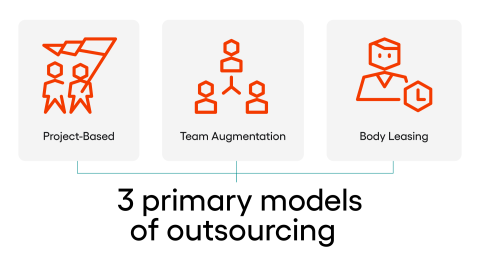
Project-based collaboration
In a project-based collaboration model, an external provider is responsible for delivering a complete solution. This approach, also known as “turnkey” or “A-Z” IT outsourcing model, ensures that you do not need to manage the development process.
Your involvement is limited to defining the project scope, budget, and timeline. Following this initial phase, the external team will continue with design, development, testing, and deployment to make sure the project meets your initial assumptions.
If you prioritise cost predictability, fixed-price agreements are the way to go. But if you need more pricing flexibility, the time and materials model is a better fit.
Cons and pros
When talking about the advantages of project-based collaboration, the key one is gaining access to specialised expertise without the need for daily management of an external workforce. You are fully covered by vendors that bring established workflows, best practices, and technical know-how to the table.
This particular model will suit you when you want to develop proof-of-concept (PoC) solutions, minimum viable products (MVPs), or bespoke enterprise applications.
Yet, there might be some challenges when you execute a project on a fixed-price model. In this case, unclear initial requirements can increase the risk of miscommunication, potentially causing deviations from your actual needs.
Furthermore, your limited involvement throughout the development phase may result in a final product that does not meet your initial requirements. To prevent this situation from happening, it is crucial to establish precise project requirements from the outset and maintain communication with all stakeholders.
Read our full article for more information on Strategies for Successful Fintech Development Outsourcing.
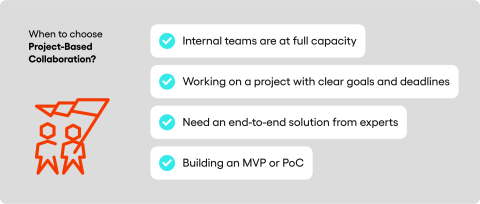
Body leasing
Body leasing allows you to access external IT professionals temporarily without the long-term commitment of permanent hires. It enables you to swiftly acquire skilled specialists, such as software developers, data engineers, or cybersecurity experts, when experiencing skill shortages while needing support for urgent projects.
The “tap on/tap off” approach allows for seamless resource adjustment, operating on weekly or bi-weekly iterations, providing flexibility and responsiveness. Quick replacement ensures continuity and performance without disrupting operations.
Cons and pros
All-inclusive costs cover everything, with no additional expenses for equipment, licenses, or employee benefits. Expertise and accountability are guaranteed with skilled professionals who bring consulting, technical expertise, and a problem-solving mindset.
While body leasing offers rapid talent deployment and adaptability to fluctuating workloads, it also presents challenges like knowledge retention and integration with internal teams.
To optimise body leasing arrangements, you should implement structured onboarding processes, establish clear expectations, and facilitate open communication to maintain continuity and efficiency.
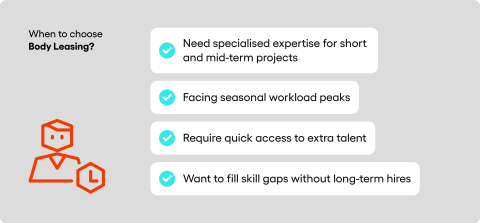
Team augmentation
Team augmentation, also known as the staff augmentation model, integrates external professionals into an organisation’s existing team. It enables you to enhance your capabilities while maintaining direct oversight of project execution.
Unlike body leasing, which primarily addresses short-term and mid-term needs, team augmentation fosters long-term collaboration by embedding external experts within internal teams.
If your company requires specialised knowledge but seeks to retain control over development processes and strategic direction, this model should be your first choice. Companies value the team augmentation model for its ability to enhance collaboration.
Cons and pros
You can expect augmented personnel to contribute to strategic planning, and provide valuable insights to fill gaps in your in-house expertise. This approach is handy for agile development teams that require flexibility and adaptability.
Let’s look at an example. Suppose your financial institution aims to enhance its fraud detection systems but lacks in-house AI capabilities. In this case, hiring AI specialists through a staff augmentation model that will not disrupt your existing workflow is the most efficient way.
Despite its benefits, the staff augmentation model may pose some risks in a few situations. Poor onboarding processes can lead to misalignment and inefficiencies. Additionally, relying too much on augmented personnel may prevent internal skill development, creating long-term dependency on external resources.
Yet, to maximise its positive effect, you should foster a collaborative environment where external professionals integrate with in-house teams while ensuring proper knowledge transfer mechanisms are in place.
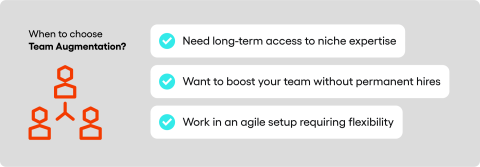
Poland as an IT hub for outsourcing
Poland has been dubbed the top destination for software development outsourcing. It offers a mix of talent availability and a business environment. With over 400,000 developers, it has the largest talent pool in Central and Eastern Europe.
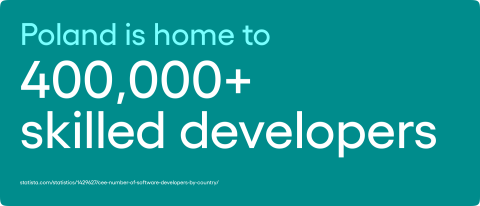
Security is another critical factor. Poland is recognised as one of the safest outsourcing locations. A score of 70.74% on the International IP Index ensures high protection for intellectual property and data security.
Polish developers consistently rank among the best globally in programming competitions. Additionally, the high level of English proficiency facilitates collaboration with international clients.
Poland’s location makes it an attractive destination for outsourcing. As a nearshore outsourcing hub for European businesses, it allows you to communicate without time zone constraints. Example? You can have a business meeting in Gdańsk in the morning and return home the same evening—something very challenging with offshore destinations.
In addition, market forecasts indicate that Poland’s outsourcing market will reach $5.38 billion by 2029, proving the country to be a powerhouse of IT in Europe.
Conclusion
Many factors must be taken into account when choosing between team augmentation, body leasing, and project-based collaboration. Each option has its pros and cons and a preferable use case. To recap:
- Project-based collaboration is perfect for fully outsourced projects with specific goals;
- Body leasing provides agility in managing resources;
- Team augmentation enhances your internal capabilities with external expertise.
Regardless of which model best suits your needs, Poland offers them all. By engaging with Polish outsourcing companies such as Speednet, you can take advantage of the benefits the Polish market has to offer.
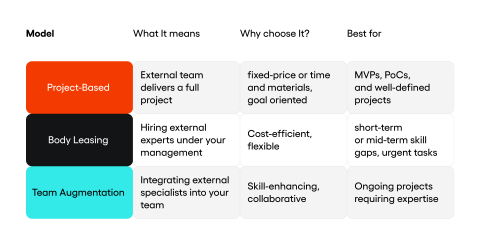
FAQ
What is an IT outsourcing model?
- An IT outsourcing model is a framework that guides companies in collaborating with an outsourcing partner to execute projects efficiently. Businesses use different IT outsourcing strategies to reduce costs and improve project delivery speed.
What are the most popular types of IT outsourcing models?
- Project-based model: an outsourcing vendor manages the entire project from start to finish;
- Body leasing in IT: The company hires individual IT specialists on a short-term or mid-term period;
- IT staff augmentation: external professionals integrate into an existing team, with long-term collaboration in mind.
Why didn’t we include a dedicated team model in our classification?
- Speednet doesn’t heavily rely on rigid classifications. That’s why, in this article, we’ve kept it simple with just three main categories, skipping the dedicated team model.
What are the main advantages of project-based outsourcing?
Project-based model outsourcing is ideal when you need the following:
- A structured, fixed-cost contract;
- A fully managed external team from an outsourcing vendor;
- Minimal internal supervision.
This model ensures a predictable budget and fast delivery, making it a preferred choice for companies lacking in-house IT expertise.
What is the difference between body leasing and IT staff augmentation?
- Body leasing in IT: businesses temporarily hire IT specialists for short-term or mid-term projects without long-term commitments;
- IT staff augmentation: experts from an external service provider are integrated into the in-house team.
What are the differences between onshore outsourcing, nearshore outsourcing, and offshore outsourcing?
- Onshore outsourcing: hiring an external service provider within the same country;
- Nearshore outsourcing model: hiring teams in nearby countries with similar time zones and cultural alignment;
- Offshore outsourcing: working with teams in distant locations, often with lower costs.
Depending on your project needs, each approach has advantages and trade-offs. In the next article, we’ll explore the differences between onshore and offshore outsourcing in more depth.
What are the risks of IT outsourcing?
Potential risks include:
- Team management problems related to communication barriers and cultural differences in offshore outsourcing;
- Quality control issues with an unverified outsourcing vendor;
- Dependency on an external service provider.
Proper vendor selection and clear contracts help mitigate these risks.
How do I ensure a successful IT outsourcing?
To maximise success with an IT outsourcing strategy:
- Define clear project requirements;
- Choose the right IT outsourcing model based on your needs;
- Implement strong communication channels.
How do IT outsourcing models impact business scalability?
- Project-based outsourcing is a solution for businesses with fluctuating needs. It allows you to work with an outsourcing partner without risks of long-term commitments;
- Body leasing in IT and IT staff augmentation allow you to scale your team depending on your current needs. You can hire specialists for short-term projects or extend partnerships with professionals who integrate with your in-house team for a longer time span.
What factors should influence my choice of IT outsourcing vendor?
- Expertise – Proven experience in banking or fintech, payments, AI, and data analytics;
- Compliance – Knowledge of regulations like GDPR, PSD2, AML, and KYC;
- Security – Strong encryption, access control, and regular audits;
- Industry Experience – Case studies and client testimonials;
- Agile Collaboration – Clear reporting and efficient project management;
- Support – Reliable maintenance and SLAs;
- Pricing – Fixed or flexible models to match project needs;
- Scalability – Future-proof solutions and innovation.
Read our full article, Choosing the Right Partner for Fintech Development Outsourcing, where we elaborate more on the factors to consider when deciding to cooperate with an outsourcing company.
This blog post was created by our team of experts specialising in AI Governance, Web Development, Mobile Development, Technical Consultancy, and Digital Product Design. Our goal is to provide educational value and insights without marketing intent.




